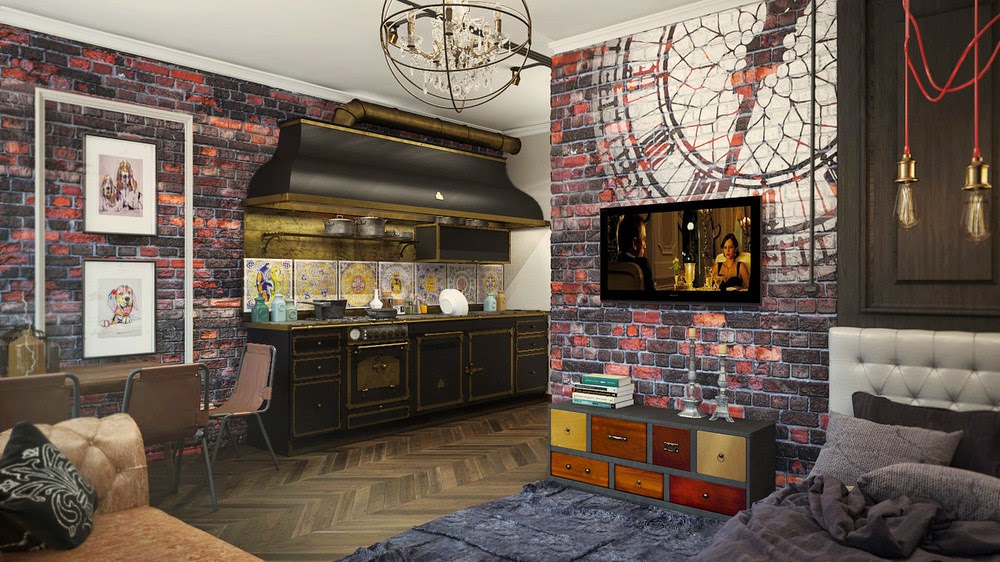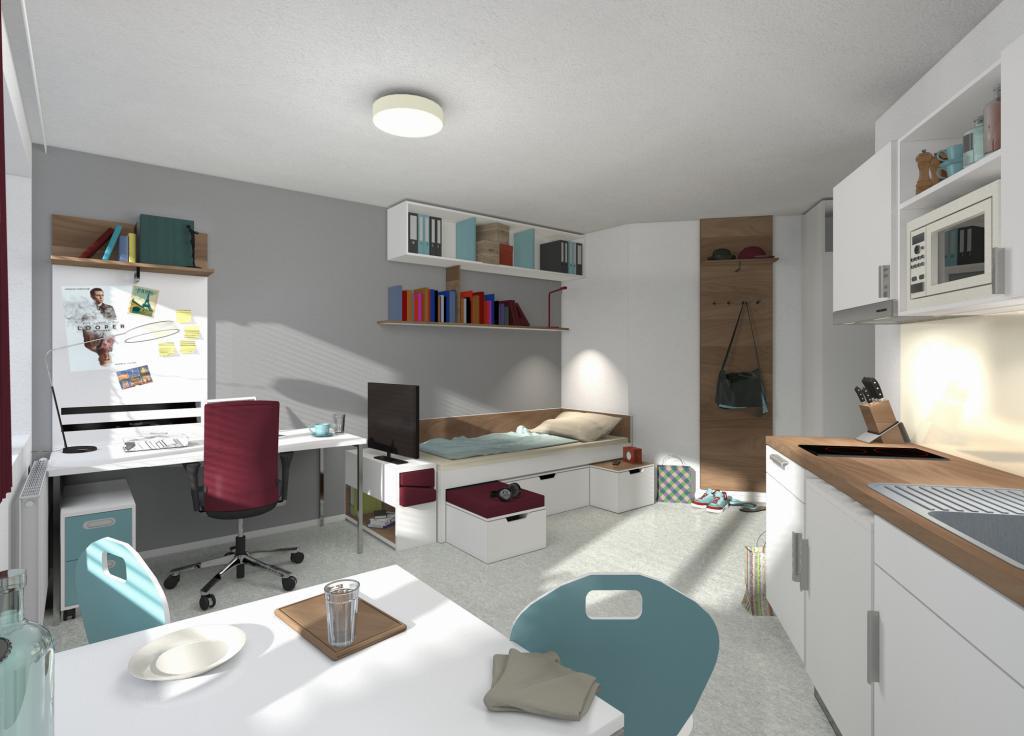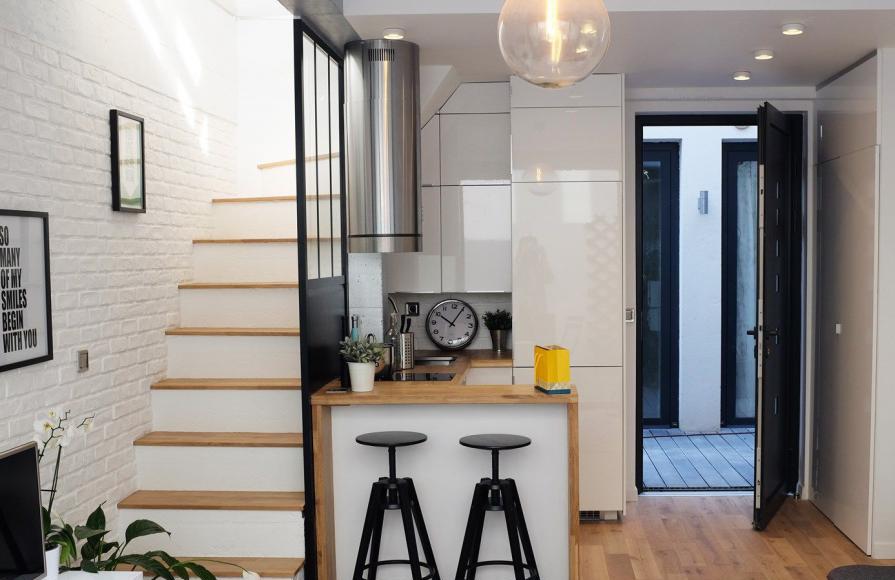In recent years, studio apartments have become quite popular. The absence of walls makes space easier and more open, but it requires competent zoning both in terms of functionality and hygiene. This issue is especially relevant for a kitchen combined with an entrance hall. In today's article we will talk about the features of such a union, its advantages and disadvantages. The design photos of kitchens combined with hallways presented in the article will inspire you to bold creative solutions, and expert advice will help make the combined space functional and stylish.
Features
Combined kitchens with corridors can be found in modern studio apartments, private houses, apartments with a free plan. The kitchen, combined with the entrance hall, may be the result of the original layout, a bold design decision or redevelopment due to the need to increase the usable space of small-sized housing. First of all, this solution is suitable for those who rarely cook at home. In other cases, the kitchen should be a separate room.

When combining such completely different functional areas, the main problem is the issue of hygiene. The kitchen is the place of cooking and eating, and the entrance hall is the area into which dirt and dust from the street get, even if there is an entrance space in front of the apartments. This is still a place with a lot of garbage and bacteria that we bring to the house on shoes and clothes. This feature of the hallway combined with the kitchen requires the use of a closed storage system for clothes and shoes, as well as the rejection of open shelves in the cooking and eating area. Cleaning the combined space will have to be carried out at times more often.
Benefits
The kitchen, combined with the entrance hall, has several advantages, among which:
- Useful area increase. Due to the absence of a partition and a doorway, it becomes possible to use the vacant space for furniture. You can install an additional kitchen cabinet or increase the space of the wardrobe.
- Openness and lightness. The combined space creates a feeling of spaciousness and a larger area of the apartment than it actually is.
- Natural lighting in the entrance area. The entrance hall, as a rule, has no windows, so when it is combined with the kitchen, a small amount of natural light will enter the corridor.
- More ergonomic shape of the room. If you combine two narrow rooms, you can get one more successful shape, which will make it possible to conveniently and functionally place furniture.
- The ability to implement creative ideas. A large area of the room allows you to realize more options for arranging space.
disadvantages
Despite the many advantages of the kitchen interior combined with the entrance hall, the disadvantages of such a planning solution are no less:
- Frequent cleaning. When combining space, dust from clothes and shoes will actively get into the kitchen area, which will require more frequent and thorough cleaning.
- Smells. Even with a powerful hood, a certain amount of steam and smells during cooking will spread, so in order to avoid soaking them with clothes, hats and bags they will have to be kept in tightly closed cabinets. This will cause certain inconvenience if it becomes necessary to dry clothes in the event of exposure to rain or snow. Wet items should not be hung in a closed cabinet, this can cause mold and an unpleasant odor, and clothing will be damaged.

- Safety and convenience. The minimum width of the passage in a room furnished with furniture should be 1.2 meters. This requirement is due to concern for the convenience and safety of residents. Two people should be able to warm up in the aisle without touching the dishes on the table and without spoiling the clothes on the hob.
- Documenting. Any redevelopment must be agreed with the appropriate authorities. Bureaucratic delays make this process long and costly.
Under what conditions can a redevelopment be done
The combination of the kitchen and the hallway is possible only if certain conditions are met, otherwise you will not be given permission to redevelop, and if you unauthorizedly join you will have to pay a fine and return everything to its original condition at your own expense.
- Gasified kitchen cannot be combined with the entrance hall. The gas stove must be in an isolated room with a mandatory door. Arched openings are also prohibited.
- When combining the kitchen and the hallway, you need to make sure that the apartment does not have a bathroom on top of this site, and the living room or gasified kitchen is in the apartment below.
- The room must have a window for ventilation.
- You can only demolish partitions that are not bearing.
- The width of the aisles in a furnitureed joint room should be at least 1 m 20 cm. These are fire safety requirements.
Decorating Tips
When designing a kitchen combined with a living room and an entrance hall, it is best to adhere to minimalism or restrained classics. Decorate the combined space should be in a single color scheme. This technique allows you to achieve harmony in the room and expand the space, as in the photo. A kitchen combined with an entrance hall often suffers from a lack of natural light. The use of light colors will level this disadvantage and make the room visually spacious.
Designers recommend using two to four shades to create additional volume in the room. Light colors are closer, dark in depth. Practical application of the “60-30-10” rule will create an organic and stylish room, as in the photo. The entrance hall, combined with the kitchen, will appear larger if reflective glossy, glass and mirror surfaces are used in the decoration. This can be a glossy stretch ceiling, chrome parts, large mirrors, framed photographs under glass, a glass apron in the work area.

Finishing materials for the combined room should have wear resistance, practicality, easy to clean. For flooring, ceramic tiles, artificial stone, laminate flooring of at least 32nd grade are suitable. Walls are better to be painted or pasted over with moisture resistant washable wallpapers. In the decoration of a small kitchen combined with an entrance hall, unnecessarily large and bright decor should be avoided. Patterned wallpaper and rich ornament on the facades of furniture will “eat” the space.
Zoning trim
Any combined space requires competent zoning. To highlight the kitchen in the hallway, various finishes of the floor, walls, ceiling, as well as all kinds of partitions and furniture are used.
Decorated in a single color scheme, but with different materials, the floor will create an emphasis on dividing the space without using additional techniques. For example, in the hallway you can put a laminate, and in the kitchen - ceramic tiles. In order to maintain cleanliness and obstruct the spread of garbage from the entrance area, you should pay attention to the traditional Japanese entrance hall. Right in front of the entrance, the floor level is a little lower, about one step. The width of the recess rarely exceeds a meter. This is enough for free opening the door and comfortable putting on shoes. Street shoes are always left in this niche, so the rubbish is not carried around the house. There you can install a shelf for shoes to maintain order.

In order to highlight the functional areas in the combined hallway, kitchen and hall, you can use the differences in ceiling level. Layered structures look very impressive, but are suitable only for spacious rooms. In a small room they will overload the space.
Zoning with partitions and furniture
Partitions are the most obvious way of zoning. For combined with the hallway of the kitchen, models made of glass, plastic, wood, metal are suitable. The kitchen-hallway is a rather aggressive environment, so the material of the partition should be easy to clean. For the same reason, tissue zoning will not be appropriate. Textiles actively absorb odors, which will be difficult to get rid of subsequently. Partitions can be stationary or sliding, solid or through. The latter is preferable, since they do not overload the space, while maintaining a sense of openness and lightness of the interior.
Another option for zoning is furniture. As a separator, racks, a bar counter, a kitchen cabinet, a peninsula are used.
Lighting
Lighting plays an important role in the design of a kitchen combined with an entrance hall. In the combined space, a large chandelier in the center will not be appropriate. Instead, they use zone lighting. In the corridor, spotlights, spotlights, wall sconces are used. Particular attention should be paid to illuminating the mirror and wardrobe. Properly configured lamps with a motion sensor at the door and inside the wardrobe will facilitate daily work fees and help save on energy consumption.
For the kitchen zone, rotary spotlights built into the ceiling and furniture, spotlights are also suitable. Particular attention should be paid to the illumination of the working area.
If during the repair of the kitchen combined with the entrance hall there is still room for a dining area, it can be emphasized with the help of a laconic pendant chandelier or a cascading lamp.
Furniture Arrangements
Ease of use of functional areas largely depends on the ergonomic arrangement of furniture. For example, in the kitchen space, the location of the refrigerator, stove and sink is of particular importance. It is advisable to place them in a corner, this option is most convenient in operation. However, the angular model does not always fit the shape of the room.
Often when combining the kitchen and the hallway, a long and narrow room is obtained. In this case, it is better to arrange the furniture linearly along one wall, and leave the second free.
Two-row and U-shaped arrangement of furniture is often found in private houses, and L-shaped - in studio apartments.
Kitchen Area Tips
When arranging the kitchen area, only closed cabinets should be used. On open surfaces, dust will collect due to the close proximity to the hallway. It is advisable to install built-in appliances that can be hidden behind the facades, while maintaining the unity of the composition.
If the shape of the room allows, taking into account the required fire safety of the width of the aisles, it is recommended to install pedestals with a depth of about 70–80 cm against the standard 60 cm. This will allow installing the sink and hob a little further from the edge of the countertop, which will help to maintain cleanliness and greater safety when moving along room.
In confined spaces, it is important to use the entire height of the room. Mezzanines in the kitchen area will allow you to place things that are rarely used, without reducing the useful area of the room.
In the combined space combined with the hallway of the kitchen, both in a private house and in an apartment you can not do without a powerful hood.
Cabinet furniture, painted in the same shade as the walls, will allow bulky interior items to “dissolve” in space without attracting attention. Such a technique will make the interior easier, and the room visually larger. The expansion of the space can also be achieved using glossy facades and mirror inserts.
Hallway Tips
When arranging the hallway zone in order to save space, it is recommended to use cabinet furniture of reduced depth, about 40 cm. The useful volume of cabinets can be increased by using the entire height of the room. Such a redistribution will allow us to maintain usable volume when using a minimum area. Narrow and tall shoe racks and chests of drawers fully retain their functionality, but take up quite a bit of space.
It is worth giving preference to sliding doors, rather than swing doors, since the latter take up a lot of space. The mirror facade of the wardrobe is able to visually double the space of the hallway.
Dining area tips
In the combined space of the kitchen-hallway, there is rarely a place for a dining area. In this case, its functions are performed by the bar counter. However, if 1-2 square meters remain. m free space, organize a dining area is not difficult.
With a lack of space, it is worth paying attention to multifunctional and transforming furniture: extendable tables, folding shelves, folding chairs.
To make the space lighter and more airy, a table with thin chromed legs with a glass surface and laconic transparent chairs made of polycarbonate will help.
Combining a kitchen with a hallway is a difficult but doable task. The correct arrangement of furniture, the use of zoning techniques and visual expansion of space, effectively organized lighting will create a harmonious and functional room, even on a limited area.